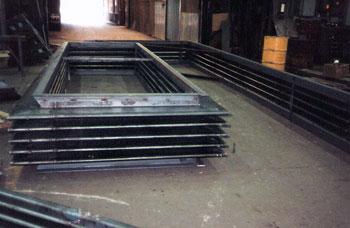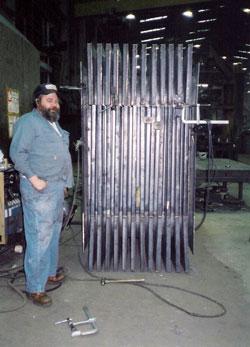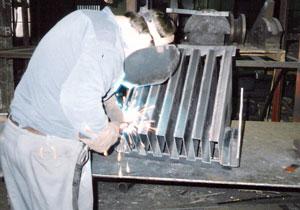AWS CWI, CWE, NDE Level III
- FMA
- The Fabricator
- FABTECH
- Canadian Metalworking
Categories
- Additive Manufacturing
- Aluminum Welding
- Arc Welding
- Assembly and Joining
- Automation and Robotics
- Bending and Forming
- Consumables
- Cutting and Weld Prep
- Electric Vehicles
- En Español
- Finishing
- Hydroforming
- Laser Cutting
- Laser Welding
- Machining
- Manufacturing Software
- Materials Handling
- Metals/Materials
- Oxyfuel Cutting
- Plasma Cutting
- Power Tools
- Punching and Other Holemaking
- Roll Forming
- Safety
- Sawing
- Shearing
- Shop Management
- Testing and Measuring
- Tube and Pipe Fabrication
- Tube and Pipe Production
- Waterjet Cutting
Industry Directory
Webcasts
Podcasts
FAB 40
Advertise
Subscribe
Account Login
Search
Industrial espionage?
How one company unwittingly lost the market for its niche product
- By Professor R. Carlisle "Carl" Smith
- November 5, 2012
- Article
- Shop Management
I would really like to know what constitutes “industrial espionage.” In my career, I have witnessed several cases that I would label as such. It seems that something that is not patented can be duplicated at will, without any repercussion whatsoever. This is especially true when your company is dealing with a customer that wishes to find the same product that your company produces at a lower price. In some cases, this end user may decide to produce the desired item rather than purchase it from your company, or pass critical production methods on to a company that will produce it for them at a lower price.
I have worked and inspected for several companies that inadvertently gave up information that practically destroyed the market for some of their specialty items. One of these companies had a niche for producing expansion joints for ductwork in power plants, steel mills, and other types of industries that used hot ductwork. This company manufactured hundreds, if not thousands, of these joints over the years, and its story is an example of possible industrial espionage.
The Product
When a duct system heats up, the metal expands; when it cools, the metal contracts. Without the use of expansion joints, the ductwork will crack or tend to move on its mounting, which causes it to collapse. Expansion joints can be placed in vertical sections or horizontal sections of the ductwork.
Expansion joints come in many types and shapes. Probably the most popular one is what is known as the “camera-fold” style. The camera-fold joint is the most difficult to manufacture because it has rounded corners. The advantage of rounded corners is that they allow joints to expand and contract thousands of times without failing (Figure 1).
The company that I am alluding to had a joint tested to 200,000 cycles without failure. Chances are a joint will expand and contract only 10,000 times in its lifetime. This company explored using several different types of material to make these joints, and in doing so, discovered that in most instances, weathering steel (ASTM A588) was the best all-around choice. In the case of extreme condensation, the weathering steel stood out far above the other types. The ASTM A387 Grade 11 (Chromium Molybdenum alloy) is good for weathering, but not as fatigue-resistant.
Rounded-edge joints made from A588 quickly grew in popularity industry wide. If an engineer considers their design, it is obvious that it takes very talented press operators and equally talented diemakers and fitters to successfully make these bends and set them up for welding (Figure 2).
This company produced round joints for heated air or gas ducts that also were of the camera-folded or square-cornered style. It designed and made all the dies—about 500—for the press brakes used to form the joints, which were formed in 180-degree segments and then welded together (Figure 3).
The square-cornered joints were not as popular, but some customers preferred them because they could be made with standard dies and, therefore, cost less than camera-fold joints. Also, access to the weld joint in the square-cornered design was much better, as shown in Figure 4. The internal bends on the camera-fold joints are the same as the external bends, which limits access to the weld area and also makes these joints more expensive to produce.
The Process
As you observe the configuration of any of these joints, you can easily see that the weld joints are extremely difficult to access. This company made or purchased special tools that were altered to give the welder access to the weld area, a method that probably should have been kept secret or patented.
The welders were required to weld on some very thin material. Most of the joints were 16 gauge (1/16 in. thick). On occasion some were 18 and 20 gauge. The welders were specialists in expansion joint production and could handle 0.030-in. wire as well as any other size. A downhill welding progression was used when possible to minimize the likelihood of burn-through (Figure 4).
The company developed all of the cutting, bending, fitting, and welding procedures over a time period of several years. The workers were trained over the years, and many of them were third-generation cutters, benders, fitters, and welders. In one case, four generations had worked on the same machines.
The Job
A strange thing happened on a job for a brand-new, overseas power generation company that was recommended to the company—the joint manufacturer—by possibly the largest producer of power generation equipment in the world. The customer had two (so-called) inspectors on-site for most of the job. Neither could speak English very well, and my workers had difficulty communicating with them. One of my welders actually took a day off because one of the guys borrowed a welding helmet and was looking over his shoulder with a camera in his hand.
I worked straight through the weekend (slept a little in the office) and watched as the inspectors filmed every move we made. They filmed me while I was performing fluorescent penetrant examinations on the joints. They even asked to see the spreadsheet that I used to accept or reject the joint.
Of course, my QC job package contained information about the A588 material and the AWS classification and specification for the wire.
The joint material was welded to A36 angles that allowed bolt holes to be placed in them for joining sections together and for fastening mounting brackets. These so-called inspectors measured the length and width of each part before and after fabrication. They even measured and photographed the dies we used on the job, and one of my workers saw them photographing other dies in the storage area.
At this point I called my supervisor and told him what was going on. He said there was nothing he could do since we agreed to a contract that said they could observe and photograph all phases of the work. I argued that they shouldn’t be allowed in any other part of the plant. He called the sales manager, who said these people were going to be huge customers because they had several power plants. At that point I gave in with reservations. Something was just not right.
They were making phone calls and sending e-mails a mile a minute, but I couldn’t understand what they were saying, because I didn’t speak their language; nor could I read their e-mails, even though I looked over their shoulders.
Near the end of the job, they went back over all the machines and took more pictures and looked at the leftover pieces that were by the press. They even took pictures of parts for other customers that were not even expansion joints.
My supervisor thought I was a bit paranoid, and I admit that I was very skeptical, but I had not seen such behavior in my nearly 50 years in the business. I had to ask them why they were taking pictures of items that did not concern their job. They appeared to be unable to understand what I was saying.
When the truck came to carry the joints to the Port of Charleston in South Carolina, these inspectors filmed the complete loading process. We had a special way of loading the joints to eliminate the possibility of buckling the thin material. We used leather-lined slings to minimize the scraping and scratching. They took close-up photos of all the loading equipment and apparatus and did not leave the plant until the truck pulled away and headed down the interstate. There were 10 more truckloads to build and ship, but we did not see another person posing as an inspector after that first load (Figure 5).
The Aftermath
This happened about five years ago, and that company has never had another large expansion order to this day. It is making small sections for emergency repairs to existing joints (Figure 6). It seems that some European or Asian company is building the expansion joints for much less than the company I worked for, even factoring in shipping them across the ocean.
Is this industrial espionage or not?
About the Author

Professor R. Carlisle "Carl" Smith
Weld Inspection & Consulting
PO Box 841
St. Albans, WV 25177
304-549-5606
subscribe now

The Fabricator is North America's leading magazine for the metal forming and fabricating industry. The magazine delivers the news, technical articles, and case histories that enable fabricators to do their jobs more efficiently. The Fabricator has served the industry since 1970.
start your free subscription- Stay connected from anywhere

Easily access valuable industry resources now with full access to the digital edition of The Fabricator.

Easily access valuable industry resources now with full access to the digital edition of The Welder.

Easily access valuable industry resources now with full access to the digital edition of The Tube and Pipe Journal.
- Podcasting
- Podcast:
- The Fabricator Podcast
- Published:
- 04/16/2024
- Running Time:
- 63:29
In this episode of The Fabricator Podcast, Caleb Chamberlain, co-founder and CEO of OSH Cut, discusses his company’s...
- Trending Articles
AI, machine learning, and the future of metal fabrication

Employee ownership: The best way to ensure engagement

Steel industry reacts to Nucor’s new weekly published HRC price

Dynamic Metal blossoms with each passing year

Metal fabrication management: A guide for new supervisors

- Industry Events
16th Annual Safety Conference
- April 30 - May 1, 2024
- Elgin,
Pipe and Tube Conference
- May 21 - 22, 2024
- Omaha, NE
World-Class Roll Forming Workshop
- June 5 - 6, 2024
- Louisville, KY
Advanced Laser Application Workshop
- June 25 - 27, 2024
- Novi, MI






























